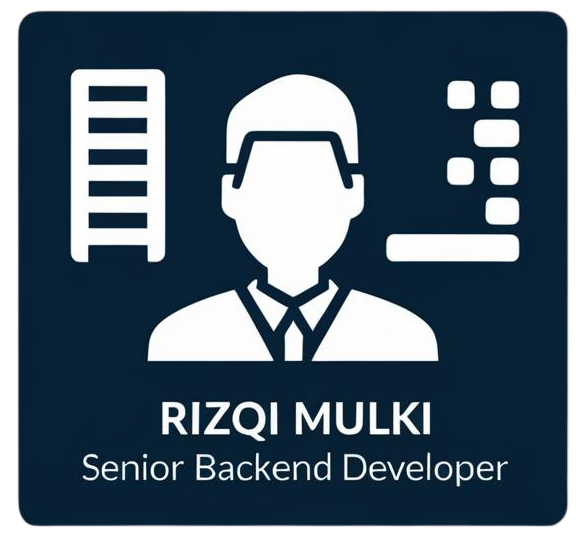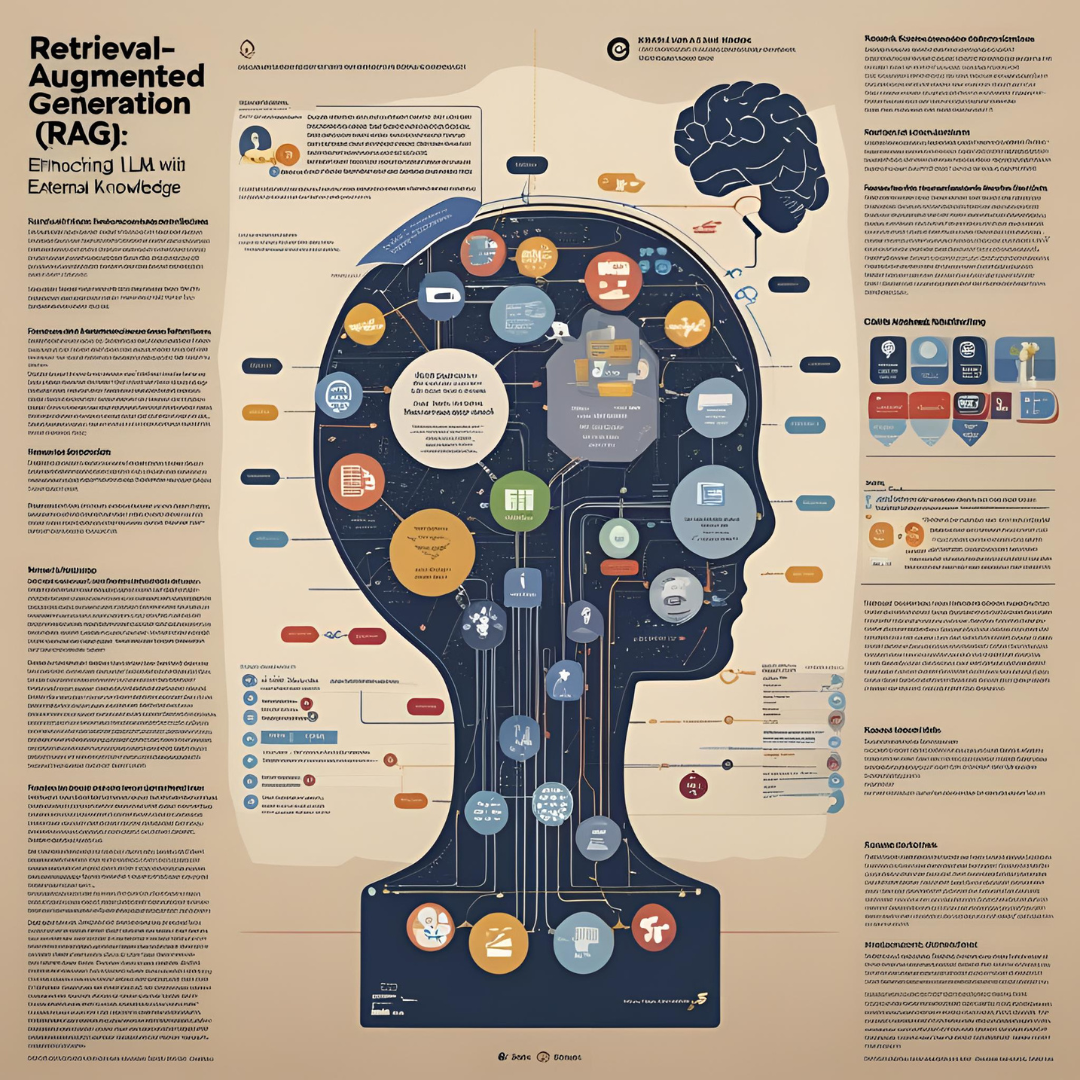Retrieval-Augmented Generation represents a paradigm shift in how we approach the limitations of Large Language Models. While LLMs demonstrate remarkable capabilities in language understanding and generation, they face inherent challenges including knowledge cutoffs, hallucinations, and inability to access real-time or domain-specific information. RAG addresses these limitations by combining the generative power of LLMs with dynamic access to external knowledge sources, creating more accurate, up-to-date, and contextually relevant AI applications.
Understanding the RAG Architecture
At its core, RAG operates through a two-stage process that seamlessly integrates information retrieval with text generation. The first stage involves retrieving relevant information from external knowledge sources based on the user’s query or context. The second stage augments the original prompt with this retrieved information, providing the LLM with specific, relevant context to generate more accurate and informed responses.
This architecture fundamentally changes how LLMs access and utilize information. Instead of relying solely on knowledge encoded in model parameters during training, RAG enables models to access vast, updateable knowledge repositories dynamically. This approach combines the fluency and reasoning capabilities of LLMs with the precision and currency of structured information retrieval systems.
The retrieval component typically employs vector databases and semantic search techniques to identify relevant information. Documents and knowledge sources are pre-processed into embeddings that capture semantic meaning, allowing for sophisticated matching between queries and relevant content. This semantic understanding goes beyond keyword matching, enabling the system to find contextually relevant information even when exact terms don’t match.
The Knowledge Retrieval Process
The retrieval process begins with query preprocessing, where user inputs are analyzed and potentially reformulated to optimize search effectiveness. This might involve query expansion, entity extraction, or intent classification to better understand what information would be most relevant for generating a helpful response.
Vector embeddings play a crucial role in this process. Both the query and the knowledge base documents are converted into high-dimensional vector representations that capture semantic meaning. Similarity calculations between these vectors identify the most relevant documents or passages for inclusion in the generation context.
Modern RAG systems often employ sophisticated ranking and filtering mechanisms to ensure retrieved information is not only relevant but also of high quality and credibility. This might include source authority scoring, recency weighting, or domain-specific relevance measures that help prioritize the most valuable information for the generation task.
The retrieved information is then formatted and integrated into the prompt structure, providing the LLM with specific context while maintaining the conversational flow. This integration requires careful prompt engineering to ensure the model utilizes the provided information effectively while maintaining natural language generation capabilities.
Implementation Strategies and Architectures
RAG implementations vary significantly based on use case requirements and technical constraints. Simple RAG systems might retrieve a few relevant documents and include them directly in the prompt context. More sophisticated implementations employ multi-stage retrieval, re-ranking algorithms, and dynamic context management to optimize both relevance and computational efficiency.
Dense retrieval systems use neural embeddings to capture semantic relationships, while sparse retrieval methods like BM25 focus on keyword matching. Hybrid approaches combine both techniques, leveraging the strengths of semantic understanding and exact term matching for comprehensive information retrieval.
Hierarchical RAG architectures handle large knowledge bases by implementing multi-level retrieval systems. Initial broad searches identify relevant domains or categories, followed by focused searches within those areas. This approach scales effectively for enterprise applications with vast, diverse knowledge repositories.
Real-time RAG systems integrate with live data sources, APIs, and streaming information feeds. These implementations require careful consideration of latency, data freshness, and system reliability to ensure consistent performance while accessing dynamic information sources.
Vector Databases and Embedding Technologies
Vector databases serve as the foundation for effective RAG implementations, providing scalable storage and search capabilities for high-dimensional embeddings. These specialized databases optimize for similarity search operations, enabling rapid identification of relevant content from millions or billions of documents.
Popular vector database solutions include Pinecone, Weaviate, Chroma, and FAISS, each offering different trade-offs between performance, scalability, and feature sets. The choice depends on factors including data volume, query patterns, update frequency, and integration requirements with existing infrastructure.
Embedding models transform text into vector representations, with different models optimized for various types of content and use cases. General-purpose models like OpenAI’s text-embedding-ada-002 work well for diverse content, while domain-specific models might provide better performance for specialized applications like scientific literature or legal documents.
The quality of embeddings directly impacts RAG system performance. Considerations include embedding dimensionality, model training data alignment with your use case, and computational requirements for both embedding generation and similarity search operations.
Knowledge Base Preparation and Management
Effective RAG systems require careful preparation and ongoing management of knowledge bases. This process begins with content ingestion, where documents are processed, cleaned, and structured for optimal retrieval performance. Different content types require different processing approaches – structured data might be indexed directly, while unstructured documents need chunking, cleaning, and metadata extraction.
Document chunking strategies significantly impact retrieval effectiveness. Chunks must be large enough to provide meaningful context but small enough to maintain relevance and fit within model context windows. Overlapping chunks, hierarchical chunking, and semantic boundary detection help optimize this balance.
Metadata enrichment enhances retrieval precision by adding structured information about documents, including creation dates, authors, topics, document types, and custom categorizations. This metadata enables filtered searches and helps prioritize information based on relevance criteria specific to your application.
Version control and update management become critical for dynamic knowledge bases. Systems must handle content updates, deletions, and versioning while maintaining search index consistency and avoiding stale information in retrieval results.
Advanced RAG Techniques and Optimizations
Multi-query RAG generates multiple variations of user queries to capture different aspects or phrasings of information needs. This approach helps overcome limitations of single-query retrieval and ensures comprehensive coverage of relevant information.
Contextual compression techniques summarize or filter retrieved content to maximize relevance while minimizing context window usage. This might involve extractive summarization, relevance filtering, or intelligent passage selection based on query-document alignment scores.
Iterative retrieval enables multi-turn information gathering where initial retrieval results inform subsequent searches. This approach works particularly well for complex queries that require information synthesis from multiple sources or domains.
Self-reflective RAG systems evaluate the quality and relevance of retrieved information before generation, potentially triggering additional retrieval rounds or adjusting generation parameters based on information confidence scores.
Domain-Specific Applications and Use Cases
Enterprise knowledge management represents one of the most impactful RAG applications. Organizations use RAG to make internal documentation, policies, and institutional knowledge accessible through natural language interfaces. This democratizes access to information while ensuring responses are grounded in authoritative company sources.
Customer support applications leverage RAG to provide accurate, up-to-date responses based on product documentation, troubleshooting guides, and support histories. This reduces response times while maintaining consistency and accuracy across support interactions.
Research and academic applications use RAG to synthesize information from vast literature repositories, enabling researchers to quickly identify relevant studies, understand research landscapes, and generate literature reviews grounded in actual publications.
Legal and compliance applications employ RAG to navigate complex regulatory frameworks, case law, and internal policies. The ability to cite specific sources and maintain audit trails makes RAG particularly valuable in these high-stakes environments.
Quality Control and Evaluation Metrics
RAG system evaluation requires multi-dimensional assessment covering both retrieval quality and generation accuracy. Retrieval metrics include precision, recall, and ranking quality measures that assess how well the system identifies relevant information. Generation metrics evaluate factual accuracy, coherence, and relevance of the final outputs.
Source attribution and citation capabilities enable users to verify information and understand the basis for generated responses. This transparency is crucial for building trust and enabling users to assess information credibility independently.
Hallucination detection becomes more sophisticated in RAG systems, where outputs can be compared against retrieved source material to identify potential fabrications or misinterpretations. Automated fact-checking and consistency verification help maintain output quality.
Human evaluation remains important for assessing nuanced aspects like helpfulness, appropriateness, and domain expertise. Regular evaluation cycles help identify areas for improvement and ensure system performance meets user expectations.
Integration Challenges and Solutions
Latency optimization requires careful balancing of retrieval depth, processing complexity, and response time requirements. Techniques include parallel processing, result caching, and progressive retrieval strategies that provide initial responses quickly while continuing to gather additional context.
Scalability considerations encompass both query volume and knowledge base size. Distributed architectures, caching strategies, and efficient indexing approaches help maintain performance as systems grow in both dimensions.
Cost management involves optimizing the trade-offs between retrieval comprehensiveness, generation quality, and operational expenses. This includes careful selection of embedding models, vector database configurations, and generation parameters that balance quality with resource consumption.
Security and privacy controls ensure that RAG systems respect access controls, data sensitivity classifications, and user permissions when retrieving and presenting information. This might involve query filtering, result redaction, or user-specific knowledge base access controls.
Monitoring and Continuous Improvement
Performance monitoring tracks key metrics including retrieval accuracy, generation quality, response times, and user satisfaction. Comprehensive dashboards help identify trends, detect issues, and guide optimization efforts.
Feedback loops enable continuous system improvement through user interactions, explicit feedback, and automated quality assessments. This information helps refine retrieval algorithms, update knowledge bases, and adjust generation parameters.
A/B testing frameworks allow systematic evaluation of different RAG configurations, retrieval strategies, and generation approaches. This enables data-driven optimization and ensures changes actually improve system performance.
Knowledge base analytics provide insights into information usage patterns, helping prioritize content updates, identify gaps, and optimize document organization for better retrieval performance.
Future Directions and Emerging Trends
Multimodal RAG extends beyond text to incorporate images, audio, video, and other media types. This expansion enables richer information retrieval and more comprehensive responses that can reference diverse content types.
Graph-based RAG leverages knowledge graphs and structured relationships to enhance information retrieval and enable more sophisticated reasoning about entity relationships and conceptual connections.
Federated RAG architectures enable information retrieval across multiple, distributed knowledge sources while respecting access controls and organizational boundaries. This approach supports complex enterprise environments with diverse information systems.
Adaptive RAG systems learn from user interactions and feedback to continuously improve retrieval and generation performance. Machine learning techniques help optimize query understanding, source selection, and response generation based on accumulated usage patterns.
Building Effective RAG Systems
Successful RAG implementation requires careful consideration of use case requirements, technical constraints, and user expectations. Start with clear definitions of success metrics, target performance levels, and acceptable trade-offs between different quality dimensions.
Prototype development should focus on core functionality before optimizing for scale or advanced features. This approach helps validate assumptions about information needs, retrieval effectiveness, and generation quality while minimizing initial complexity.
Iterative improvement based on real usage data ensures systems evolve to meet actual user needs rather than theoretical requirements. Regular evaluation and adjustment cycles help maintain system effectiveness as knowledge bases grow and user needs evolve.
Integration with existing workflows and systems maximizes adoption and value delivery. RAG systems work best when they complement rather than replace existing information access patterns, providing enhanced capabilities within familiar interfaces and processes.
RAG represents a powerful approach to enhancing LLM capabilities while addressing fundamental limitations. By combining the generative capabilities of language models with dynamic access to authoritative information sources, RAG enables more accurate, trustworthy, and useful AI applications across diverse domains and use cases. Success requires careful attention to system design, implementation quality, and ongoing optimization based on real-world performance and user feedback.


Leave a Reply